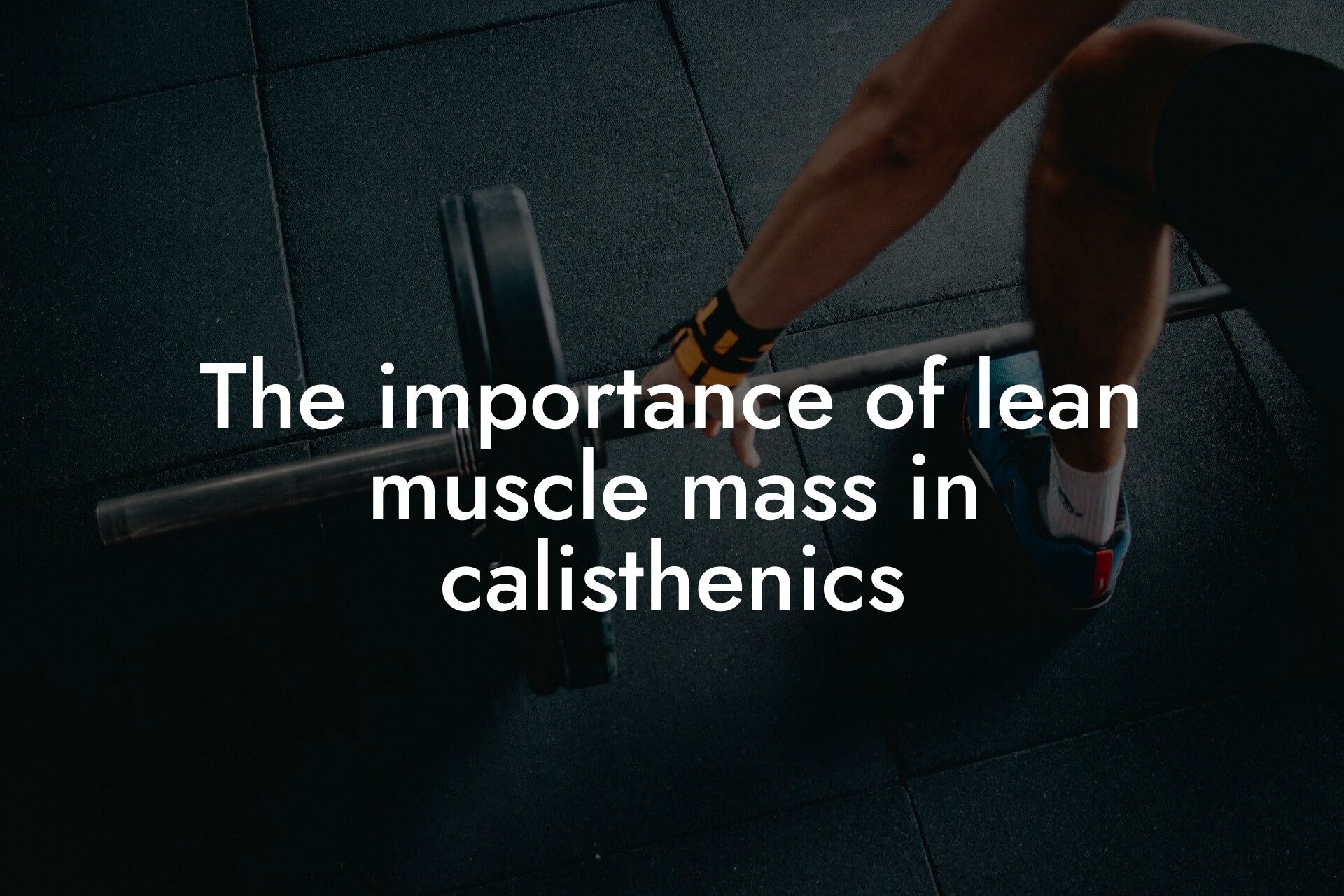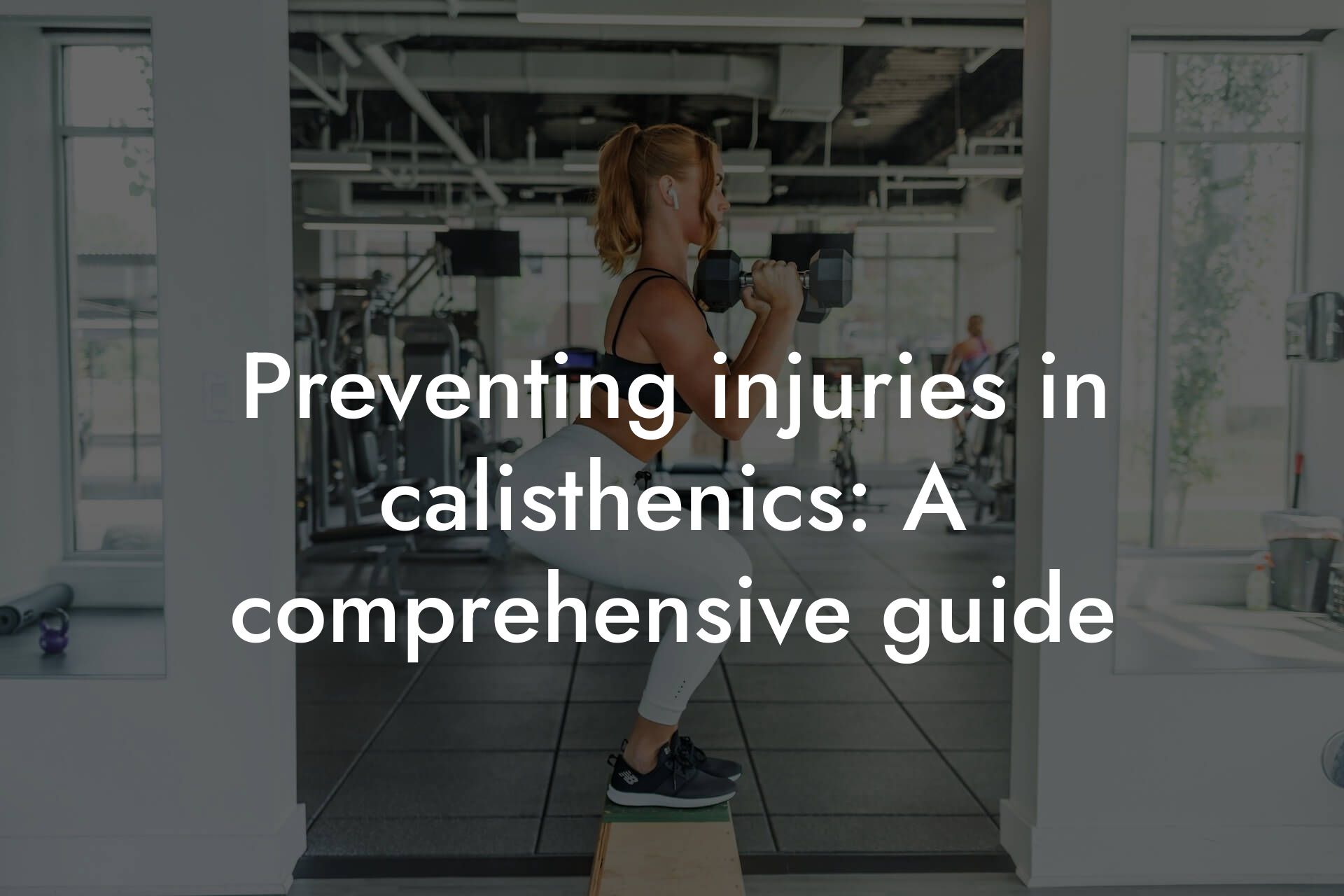As a high-earning professional, you understand the importance of maintaining a strong and healthy physique. Calisthenics, a form of exercise that uses body weight as resistance, is an excellent way to improve overall fitness and physique. However, your body composition plays a significant role in determining your performance in calisthenics. In this article, we'll delve into the relationship between body composition and calisthenics performance, and how understanding this connection can help you optimize your training and achieve your fitness goals.
Table of Contents
- What is Body Composition?
- The Importance of Lean Mass in Calisthenics
- The Role of Body Fat in Calisthenics
- How Bone Density Affects Calisthenics Performance
- The Impact of Water Composition on Calisthenics Performance
- How to Optimize Body Composition for Calisthenics Performance
- The Benefits of DEXA Scans for Calisthenics Performance
- Frequently Asked Questions
What is Body Composition?
Body composition refers to the percentage of fat, lean mass, bone density, and water in your body. It's a critical aspect of overall health and fitness, as it affects your metabolism, energy levels, and athletic performance. A healthy body composition is characterized by a high percentage of lean mass, low body fat, and optimal bone density.
The Importance of Lean Mass in Calisthenics
Lean mass, which includes muscle mass and bone density, is a crucial component of body composition. In calisthenics, lean mass is essential for generating force, power, and endurance. The more lean mass you have, the more efficient you'll be at performing exercises like push-ups, squats, and lunges. A higher percentage of lean mass also means you'll be able to recover faster from intense workouts, reducing the risk of injury and fatigue.
The Role of Body Fat in Calisthenics
Body fat, on the other hand, can hinder calisthenics performance. Excess body fat increases your overall weight, making it more challenging to perform exercises that require strength, power, and agility. Additionally, high body fat percentages can lead to decreased mobility, flexibility, and balance, making it more difficult to execute complex movements. Furthermore, excess body fat can also increase your risk of injury, as it puts additional stress on your joints and muscles.
How Bone Density Affects Calisthenics Performance
Bone density is another critical aspect of body composition that affects calisthenics performance. Strong bones provide a solid foundation for your muscles, allowing you to generate more force and power. In calisthenics, exercises like squats, lunges, and deadlifts require strong bones to support your joints and muscles. Low bone density, on the other hand, can increase your risk of injury and osteoporosis, making it more challenging to perform exercises that require heavy loads and intense movements.
The Impact of Water Composition on Calisthenics Performance
Water composition, which includes hydration levels and electrolyte balance, is often overlooked in body composition analysis. However, it plays a critical role in calisthenics performance. Proper hydration is essential for maintaining muscle function, flexibility, and endurance. Even mild dehydration can lead to decreased performance, fatigue, and increased risk of injury. Furthermore, electrolyte imbalances can disrupt muscle function, leading to cramping, spasms, and decreased athletic performance.
How to Optimize Body Composition for Calisthenics Performance
To optimize your body composition for calisthenics performance, focus on the following strategies:
- Maintain a healthy diet that includes lean protein, complex carbohydrates, and healthy fats.
- Incorporate strength training exercises that target multiple muscle groups, such as squats, deadlifts, and bench press.
- Incorporate high-intensity interval training (HIIT) to improve cardiovascular fitness and burn excess body fat.
- Stay hydrated by drinking plenty of water and electrolyte-rich beverages.
- Get enough sleep and rest to allow your muscles to recover and rebuild.
- Monitor your body composition regularly using tools like DEXA scans to track your progress and make adjustments to your training and nutrition plan.
The Benefits of DEXA Scans for Calisthenics Performance
DEXA scans are a valuable tool for tracking body composition and optimizing calisthenics performance. By providing a detailed analysis of your body fat percentage, lean mass, bone density, and water composition, DEXA scans can help you:
- Identify areas for improvement in your training and nutrition plan.
- Track changes in your body composition over time.
- Optimize your training program to target specific muscle groups and improve overall performance.
- Reduce your risk of injury by identifying potential areas of weakness or imbalance.
In conclusion, body composition plays a critical role in calisthenics performance. By understanding the importance of lean mass, body fat, bone density, and water composition, you can optimize your training and nutrition plan to achieve your fitness goals. By incorporating strategies like strength training, HIIT, and proper hydration, and monitoring your progress with tools like DEXA scans, you can take your calisthenics performance to the next level. Remember, a healthy body composition is the foundation of optimal athletic performance, and with the right tools and knowledge, you can achieve your goals and maintain a strong, healthy physique.
Frequently Asked Questions
What is body composition, and why is it important for calisthenics performance?
Body composition refers to the proportion of fat and lean mass in the body. It's a critical factor in calisthenics performance because it directly affects an individual's power-to-weight ratio, strength, and overall athleticism. A leaner body composition can improve calisthenics performance by increasing power, speed, and agility, while a higher body fat percentage can hinder performance.
How does body fat percentage impact calisthenics performance?
Excess body fat can negatively impact calisthenics performance by increasing the energy expenditure required to move the body, reducing power and speed, and increasing the risk of injury. Even a small reduction in body fat percentage can significantly improve calisthenics performance.
What is the ideal body fat percentage for calisthenics?
The ideal body fat percentage for calisthenics varies depending on the individual and their goals. Generally, a body fat percentage between 10-15% for men and 15-20% for women is considered optimal for calisthenics performance.
How does muscle mass impact calisthenics performance?
Muscle mass plays a critical role in calisthenics performance, as it directly affects an individual's strength, power, and endurance. Increasing muscle mass can improve calisthenics performance by allowing individuals to generate more force and power.
What is the relationship between bone density and calisthenics performance?
Bone density is essential for calisthenics performance, as it affects an individual's ability to withstand the impact and stress of calisthenic exercises. Low bone density can increase the risk of injury, while high bone density can improve overall performance.
How can I measure my body composition?
There are several ways to measure body composition, including dual-energy X-ray absorptiometry (DXA), skinfold measurements, bioelectrical impedance analysis (BIA), and hydrostatic weighing. It's essential to consult with a healthcare professional or certified fitness expert to determine the best method for your needs.
What are the benefits of having a lean body composition for calisthenics?
A lean body composition can improve calisthenics performance by increasing power, speed, and agility, while also reducing the risk of injury. Additionally, a lean body composition can improve overall health and well-being, boost confidence, and enhance athletic performance.
How can I achieve a lean body composition for calisthenics?
Achieving a lean body composition for calisthenics requires a combination of proper nutrition, consistent training, and patience. Focus on consuming a balanced diet with adequate protein, healthy fats, and complex carbohydrates, while also incorporating strength training and high-intensity interval training (HIIT) into your workout routine.
What role does nutrition play in body composition for calisthenics?
Nutrition plays a critical role in body composition for calisthenics, as it directly affects an individual's ability to build lean muscle mass and reduce body fat. Focus on consuming a balanced diet with adequate protein, healthy fats, and complex carbohydrates, while also staying hydrated and avoiding processed foods.
How can I increase my muscle mass for calisthenics?
Increase muscle mass for calisthenics by incorporating strength training exercises into your workout routine, focusing on compound exercises such as squats, deadlifts, and bench press. Additionally, ensure you're consuming adequate protein and calories to support muscle growth and recovery.
What is the importance of hydration for body composition and calisthenics performance?
Hydration is essential for body composition and calisthenics performance, as it directly affects an individual's ability to recover from exercise and build lean muscle mass. Aim to drink at least 8-10 glasses of water per day, and make sure to stay hydrated during and after exercise.
How can I improve my bone density for calisthenics?
Improve bone density for calisthenics by incorporating weight-bearing exercises into your workout routine, such as squats, deadlifts, and lunges. Additionally, ensure you're consuming adequate calcium and vitamin D through your diet or supplements.
What is the relationship between body composition and injury risk in calisthenics?
Body composition plays a critical role in injury risk in calisthenics, as excess body fat can increase the risk of injury, while a lean body composition can reduce the risk of injury. Additionally, strong muscles and bones can help absorb the impact and stress of calisthenic exercises, reducing the risk of injury.
How can I maintain a healthy body composition for calisthenics?
Maintain a healthy body composition for calisthenics by focusing on consistent training, proper nutrition, and patience. Avoid fad diets and quick fixes, and instead focus on making sustainable lifestyle changes that promote overall health and well-being.
What are the benefits of tracking body composition for calisthenics?
Tracking body composition for calisthenics can help individuals monitor their progress, identify areas for improvement, and make data-driven decisions about their training and nutrition. It can also help individuals stay motivated and focused on their goals.
How often should I track my body composition for calisthenics?
Track your body composition for calisthenics regularly, ideally every 4-6 weeks, to monitor progress and make adjustments to your training and nutrition as needed.
What are the common mistakes people make when it comes to body composition for calisthenics?
Common mistakes people make when it comes to body composition for calisthenics include focusing too much on weight loss, neglecting strength training, and not prioritizing nutrition. Additionally, many individuals fail to track their progress, leading to a lack of accountability and motivation.
How can I overcome plateaus in body composition for calisthenics?
Overcome plateaus in body composition for calisthenics by reassessing your training and nutrition, making adjustments as needed, and seeking guidance from a healthcare professional or certified fitness expert. Additionally, focus on progressive overload, increasing the intensity and difficulty of your workouts over time.
What is the role of genetics in body composition for calisthenics?
Genetics play a role in body composition for calisthenics, as they can affect an individual's natural body shape and composition. However, genetics are not a limiting factor, and individuals can still achieve their goals with consistent training, proper nutrition, and patience.
How can I balance body composition goals with calisthenics performance goals?
Balancing body composition goals with calisthenics performance goals requires a holistic approach, focusing on both training and nutrition. Prioritize strength training and HIIT, while also making adjustments to your diet to support muscle growth and recovery.
What are the benefits of working with a personal trainer or coach for body composition and calisthenics?
Working with a personal trainer or coach for body composition and calisthenics can provide individuals with personalized guidance, accountability, and support. They can help individuals develop a customized training and nutrition plan, track progress, and make adjustments as needed.
How can I stay motivated and accountable for my body composition and calisthenics goals?
Stay motivated and accountable for your body composition and calisthenics goals by setting clear and achievable goals, tracking progress, and seeking support from a community or accountability partner. Additionally, celebrate small victories and focus on the process, rather than the outcome.
Here are some related articles you might love...
- Using DEXA scans to monitor progress in calisthenics
- The importance of lean muscle mass in calisthenics
- Preventing injuries in calisthenics: A comprehensive guide
- Strength and conditioning programs for calisthenics practitioners
- Reducing body fat for improved strength-to-weight ratio in calisthenics
- Nutrition tips for calisthenics athletes
- Recovery strategies for calisthenics athletes
- Bone density and its role in calisthenics training
- How to build functional strength with calisthenics
Zak Faulkner
Zak Faulkner is a leading authority in the realm of physical health and body composition analysis, with over 15 years of experience helping professionals optimise their fitness and well-being. As one the experts behind Tano Performance Group, Zak has dedicated his career to providing in-depth, science-backed insights that empower clients to elevate their physical performance and overall health.
With extensive knowledge of DEXA technology, Zak specializes in delivering comprehensive body assessments that offer precise data on body fat, muscle mass, bone density, and overall physique. His expertise enables individuals to make informed decisions and achieve their fitness goals with accuracy and confidence. Zak’s approach is rooted in a deep understanding of human physiology, combined with a passion for helping clients unlock their full potential through personalised strategies.
Over the years, Zak has earned a reputation for his commitment to excellence, precision, and client-focused service. His guidance is trusted by top professionals who demand the best when it comes to their health. Whether advising on fitness programs, nutritional strategies, or long-term wellness plans, Zak Faulkner’s insights are a valuable resource for anyone serious about taking their health and fitness to the next level.
At Tano Performance Group, Zak continues to lead our Content Team revolutionising how professionals approach their physical health, offering unparalleled expertise that drives real results.




